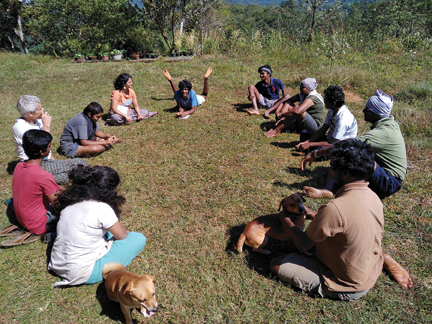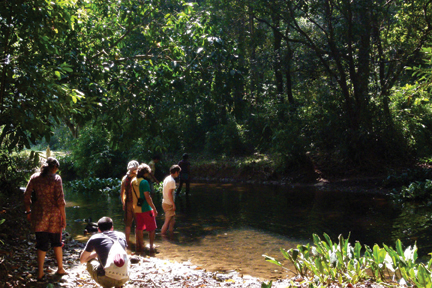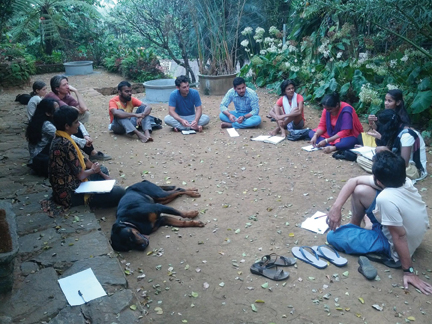Shyamal Lakshminarayanan
“It is interesting to contemplate a tangled bank, clothed with many plants of many kinds, with birds singing on the bushes, with various insects flitting about, and with worms crawling through the damp earth, and to reflect that these elaborately constructed forms, so different from each other, and dependent upon each other in so complex a manner, have all been produced by laws acting around us.” – Charles Darwin
I try to educate myself about the living world and have engaged, along with other facilitators, with participants of varying ages in outdoor rambles over the years. These outdoor rambles have taken place at the Gurukula Botanical Sanctuary, located in the Western Ghats forests in Wayanad. Our participants have come with varying aims but a key activity has been to explore the natural world and to examine our place and possible role in it.

My task has been to aid in that exploration, helping build a structure, largely based on ideas from science while also upholding, especially, some of the principles of scientific enquiry. A notable principle is to not passively accept claims or facts. This naturally forces one to review the history of received ideas. Sometimes it is hard to know or be sure of these histories. How does one act as a teacher or provocateur under these circumstances? Here I reflect on some of the areas of enquiry and challenges involved. What I share in this article is a loose guide and an indicator of some of the tangled threads of thoughts one wrangles with through dialogue.
While my particular focus has been the living world, it is not possible to impose boundaries and other facilitators have helped in dealing with matters of astronomy, planetary origins, etc. My role has chiefly been as a provocateur of thought while looking at the natural world on walks in the forest. The evolution of ideas about our world have involved a series of hypotheses, tests, critiques and alternative proposals; historically, ideas get dismissed either outright or with time, while others get refined. Trying to figure out these chains of ideas through questioning and sustained dialogue is one way of examining what underpins a specific view of the world.
These dialogues delve into a large variety of subjects, many that might require repeated visits for participants to negotiate terminology, reduce ambiguity and find a common language that allows further dialogues. Dialogues can be contentious and many questions may remain unanswered or you may be left with imperfect answers. The act of asking questions and leaving avenues for further exploration is itself a key process. These dialogues require at least some persons to lead and provide provocations, involve rather small groups and most importantly need a suitable backdrop. The subjects that we have touched upon in these outdoor sessions have largely emerged spontaneously in the field. They arise out of and are richly interspersed with first-hand observation of the natural world, including what initially appear like discrete and separable elements, plants, birds, invertebrates and smaller life forms. We approach the natural world largely with the unaided senses, but where useful, we have resorted to microscopes and binoculars. Observations in nature typically lead to questions but some participants may need to be provoked into thinking. They require at least the main provocateur to try and be an equal participant, comfortable with unpredictability and with ignorance while also reflecting on one’s own received understanding. Walks in the wilderness work especially well by keeping the senses alert and the mind active, especially to the animate living world.

When everyone begins to see themselves as just another organism (or better still, a temporary coalition of many organisms), a semblance of egalitarianism is established. It helps to work in a group that gets along well and there can be no rigid strategies nor can one define end goals; but certain concepts which are not normally taught in classrooms can be examined. One might have to examine the meanings of words, explore logic and fallacies. Selected bits from background readings shared by participants in the group greatly aid the process. The challenges are huge, one is dealing with ignorance, partial understanding and debatable bits – the kind of things that traditional teaching cannot deal with because “teaching” is largely defined as the transfer of ideas “certified” as true, and with one party under an implicit contract to accept another (compare religion or other forms of indoctrination). How do we deal with the structures of knowledge under these circumstances? I list some broad topics that I try to broach with groups against the backdrop of the natural world.
Understanding naming and convention
Going out into the wilderness exposes people to a range of living organisms and physical processes and often the initial outings involve participants seeking and putting labels on things. For young participants, getting them to make up their own labels can be a fun exercise. At some point, one has to examine how things are named and grouped. Naming itself is not science, but labels are the things by which accumulation is achieved, connections made and information organized with contributors spread out across time and space. Some systems of organization do (and have done) better and there has been a gravitation towards certain systems which then become dominant1, the dominance of modern science can itself be examined. We often walk with forest-dwelling people and we learn to respect and use their naming systems even if we understand the benefits of binomial names.
Questioning and understanding authority
Why should anyone believe anyone else or the ideas they profess? Should people be forced to believe certain ideas? What is the nature of our senses, what is evidence, experiment, hypothesis and what are natural laws? This will eventually have to deal with questions on beginnings, creation and God. How do science, morality and religion relate?
Nature and the supernatural
Exploring the origins of the universe. Looking at the stars, examining what is known about the origins, the age of the universe, the movements of galaxies, red-shifts, the elements, the composition of materials on Earth. Examining ideas on life and its origin – theistic creation, ladders of life, to trees of life, to even more complex reticulate evolution. Are humans unique in any way? Questions on consciousness, intelligence, Cartesian ideas, reductionism and holism will arise more than once and have to be examined carefully. Does a sense of wonder reduce our willingness to destroy?
Ecology, organisms, species, boundaries
Associated with the naming of living things, is the history of species definitions, the problems with boundaries, the blurring of boundaries and identities, mutualisms and our ideas on super-organisms. The ecosystem of the human body tends to be easier to relate to for many.

Humans and their place in the environment
Once we get past the idea that evolution has no teleological purpose2 or predefined plan, life as viewed by modern science can appear to be rather meaningless.3 It seems however that having an organismic perspective helps. Being able to see how plants and animals go about their lives in healthy ecosystems is something that can provide meaning and show us how we can go about our own lives.
The role of the wild
Clearly much of this cannot be done in a traditional classroom, where there is hardly any stimulating nature around. How willing would schools be to make their surroundings wilder, one where humans are not the dominant life forms? How willing would mediators be to throw away their confidence and sense of authority? I cannot claim that this is an effective approach for looking at the world through science, but it definitely has the advantage of being thoroughly enjoyable, one that reduces human conceit and elevates the role of our life-support system.
- Why, for instance, should one use the system of binomial nomenclature?
- A gentle departure from human-centricity is provided by a reading of Douglas Adams’ Hitchhikers Guide to the Galaxy. Douglas Adams’ “puddle analogy” is also a useful piece: “This is rather as if you imagine a puddle waking up one morning and thinking, ‘This is an interesting world I find myself in – an interesting hole I find myself in – fits me rather neatly, doesn’t it? In fact it fits me staggeringly well, must have been made to have me in it!’ This is such a powerful idea that as the sun rises in the sky and the air heats up and as, gradually, the puddle gets smaller and smaller, frantically hanging on to the notion that everything’s going to be alright, because this world was meant to have him in it, was built to have him in it; so the moment he disappears catches him rather by surprise. I think this may be something we need to be on the watch out for.”
- This appears to be particularly problematic among physicists and mental health issues in the higher physics community is apparently now a recognized issue.
The author has been observing the natural world for many years and blogs at muscicapa.blogspot.com; he also edits relevant content on the English language Wikipedia. He has been associated with educational programs at the Gurukula Botanical Sanctuary in Wayanad (https://www.gbsanctuary.org). He can be reached at lshyamal@gmail.com.
